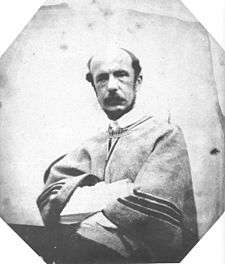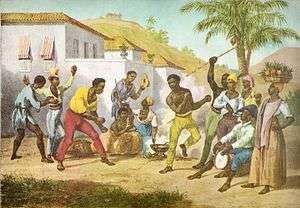Johann Moritz Rugendas

Johann Moritz Rugendas (29 March 1802 – 29 May 1858) was a German painter, famous for his works depicting landscapes and ethnographic subjects in several countries in the Americas, in the first half of the 19th century. Rugendas is also the subject of César Aira's 2000 novel, An Episode in the Life of a Landscape Painter.
Biography
Rugendas was born in Augsburg, Germany, into the seventh generation of a family of noted painters and engravers of Augsburg (he was a great grandson of Georg Philipp Rugendas, 1666–1742, a celebrated painter of battles),[1] and studied drawing and engraving with his father, Johann Lorenz Rugendas II (1775–1826). From 1815-17, he studied with Albrecht Adam (1786–1862), and later in the Academy de Arts of Munich, with Lorenzo Quaglio II (1793–1869).
Inspired by the artistic work of Thomas Ender (1793–1875) and the travel accounts in the tropics by German naturalists Johann Baptist von Spix (1781–1826) and Carl von Martius (1794–1868), in the course of the Austrian Brazil Expedition, Rugendas arrived in Brazil in 1821. There he was soon hired as an illustrator for Baron von Langsdorff's scientific expedition to Minas Gerais and São Paulo. Langsdorff was the consul-general of the Russian Empire in Brazil and had a farm in the northern region of Rio de Janeiro, where Rugendas went to live with other members of the expedition.
In this capacity, Rugendas visited the Serra da Mantiqueira and the historical towns of Barbacena, São João del Rei, Mariana, Ouro Preto, Caeté, Sabará and Santa Luzia. Just before the fluvial phase of the expedition started (a fateful journey to the Amazon), he became alienated from von Langsdorff, left the expedition and was replaced by the artists Adrien Taunay and Hércules Florence. However, Rugendas remained on his own in Brazil until 1825, exploring and recording his many impressions of daily life in the provinces of Mato Grosso, Pernambuco, Bahia, Espírito Santo and Rio de Janeiro. He produced mostly drawings and watercolors.
On his return to Europe between 1825 and 1828, Rugendas lived successively in Paris, Augsburg and Munich, with the aim of learning new art techniques, such as oil painting. There, he published from 1827 to 1835, with the help of Victor Aimé Huber, his monumental book Voyage Pittoresque dans le Brésil (Picturesque Voyage to Brazil), with more than 100 illustrations, which became one of the most important documents about Brazil in the 19th century.
He studied in Italy, but re-inspired by explorer and naturalist, Alexander Humboldt (1769–1859), whom he had once met, Rugendas sought financial support for a much more ambitious project of recording pictorially the life and nature of Latin America; in his words "an endeavour to truly become the illustrator of life in the New World". In 1831 he travelled first to Haiti, and then to Mexico. He began to use oil painting there, with excellent results. Unfortunately, Rugendas was incarcerated and expelled from the country after he became involved in a failed coup against Mexico's president, Anastasio Bustamante, in 1834.
From 1834-44 he travelled to Chile, Argentina, Uruguay, Peru and Bolivia, and finally went back to Rio de Janeiro, in 1845. Well-accepted and feted by the court of Emperor Dom Pedro II, he executed portraits of several members of the royal court and participated in an artistic exposition. At the age of 44, in 1846, Rugendas departed to Europe, never to return to Latin America.
Death
He died on 29 May 1858 in Weilheim an der Teck, Germany, King Maximilian II of Bavaria having acquired most of his works in exchange for a life pension. His painting "Columbus taking Possession of the New World" (1855) is on view at the Neue Pinakothek, in Munich.
See also
Gallery
 Costumes in Rio, 1823
Costumes in Rio, 1823 Slave hunter, 1823
Slave hunter, 1823 Indians in a farm, 1824
Indians in a farm, 1824 Capoeira or the Dance of War(1835).
Capoeira or the Dance of War(1835). Batuque, Rio de Janeiro.(1835).
Batuque, Rio de Janeiro.(1835). Customs on central Valparaíso.
Customs on central Valparaíso. Johann Moritz Rugendas.
Johann Moritz Rugendas.
References
- ↑ Lody, Raul Giovanni da Motta (2004). Cabelos de axé: identidade e resistência. Senac. p. 54. ISBN 85-7458-162-3.
Bibliography
Diener, P.: Rugendas, 1802-1858. Wissner; Museo Nacional de Bellas Artes, Augsburg and Santiago de Chile, 1997. A massive catalogue of works in Spanish and Portuguese.
External links
 Media related to Johann Moritz Rugendas at Wikimedia Commons
Media related to Johann Moritz Rugendas at Wikimedia Commons- Rugendas. On-line collection of paintings.
